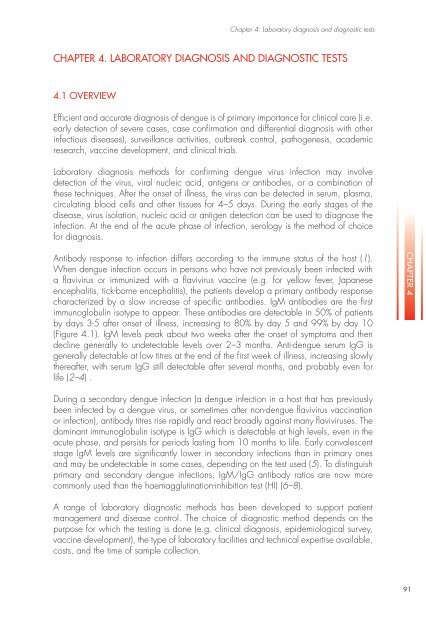dengue-diagnosis
dengue-diagnosis
dengue-diagnosis
Create successful ePaper yourself
Turn your PDF publications into a flip-book with our unique Google optimized e-Paper software.
Chapter 4: Laboratory <strong>diagnosis</strong> and diagnostic tests<br />
Chapter 4. Laboratory <strong>diagnosis</strong> and diagnostic tests<br />
4.1 Overview<br />
Efficient and accurate <strong>diagnosis</strong> of <strong>dengue</strong> is of primary importance for clinical care (i.e.<br />
early detection of severe cases, case confirmation and differential <strong>diagnosis</strong> with other<br />
infectious diseases), surveillance activities, outbreak control, pathogenesis, academic<br />
research, vaccine development, and clinical trials.<br />
Laboratory <strong>diagnosis</strong> methods for confirming <strong>dengue</strong> virus infection may involve<br />
detection of the virus, viral nucleic acid, antigens or antibodies, or a combination of<br />
these techniques. After the onset of illness, the virus can be detected in serum, plasma,<br />
circulating blood cells and other tissues for 4–5 days. During the early stages of the<br />
disease, virus isolation, nucleic acid or antigen detection can be used to diagnose the<br />
infection. At the end of the acute phase of infection, serology is the method of choice<br />
for <strong>diagnosis</strong>.<br />
Antibody response to infection differs according to the immune status of the host (1).<br />
When <strong>dengue</strong> infection occurs in persons who have not previously been infected with<br />
a flavivirus or immunized with a flavivirus vaccine (e.g. for yellow fever, Japanese<br />
encephalitis, tick-borne encephalitis), the patients develop a primary antibody response<br />
characterized by a slow increase of specific antibodies. IgM antibodies are the first<br />
immunoglobulin isotype to appear. These antibodies are detectable in 50% of patients<br />
by days 3-5 after onset of illness, increasing to 80% by day 5 and 99% by day 10<br />
(Figure 4.1). IgM levels peak about two weeks after the onset of symptoms and then<br />
decline generally to undetectable levels over 2–3 months. Anti-<strong>dengue</strong> serum IgG is<br />
generally detectable at low titres at the end of the first week of illness, increasing slowly<br />
thereafter, with serum IgG still detectable after several months, and probably even for<br />
life (2–4) .<br />
CHAPTER 4<br />
During a secondary <strong>dengue</strong> infection (a <strong>dengue</strong> infection in a host that has previously<br />
been infected by a <strong>dengue</strong> virus, or sometimes after non-<strong>dengue</strong> flavivirus vaccination<br />
or infection), antibody titres rise rapidly and react broadly against many flaviviruses. The<br />
dominant immunoglobulin isotype is IgG which is detectable at high levels, even in the<br />
acute phase, and persists for periods lasting from 10 months to life. Early convalescent<br />
stage IgM levels are significantly lower in secondary infections than in primary ones<br />
and may be undetectable in some cases, depending on the test used (5). To distinguish<br />
primary and secondary <strong>dengue</strong> infections, IgM/IgG antibody ratios are now more<br />
commonly used than the haemagglutination-inhibition test (HI) (6–8).<br />
A range of laboratory diagnostic methods has been developed to support patient<br />
management and disease control. The choice of diagnostic method depends on the<br />
purpose for which the testing is done (e.g. clinical <strong>diagnosis</strong>, epidemiological survey,<br />
vaccine development), the type of laboratory facilities and technical expertise available,<br />
costs, and the time of sample collection.<br />
91


